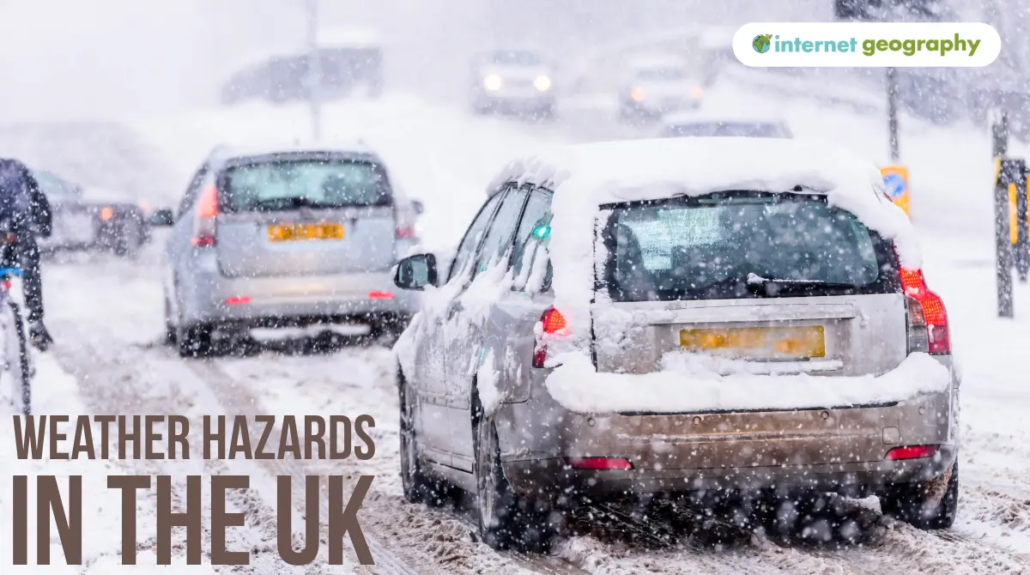Weather Hazards in the UK
Extreme weather refers to conditions that are especially severe or occur out of season. It is different from the usual weather pattern. Most parts of the UK are at risk from several types of extreme weather. Different air masses that affect the UK bring a range of weather conditions.
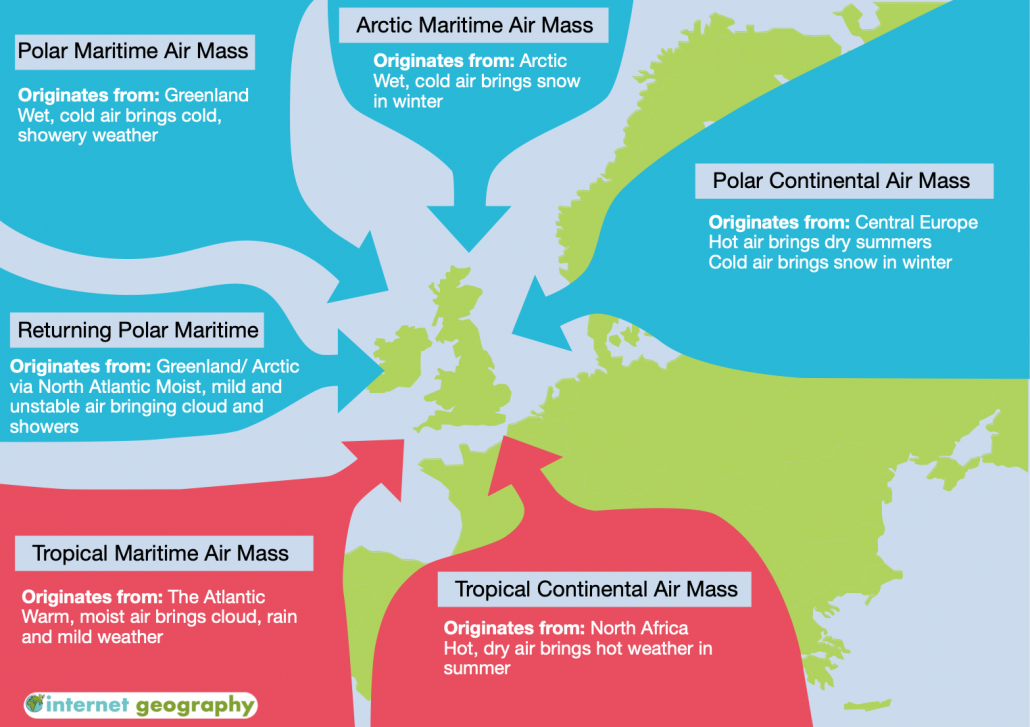
UK Air Masses
The UK experiences a wide range of weather hazards. These include rain, wind, snow and drought.
What are weather hazards in the UK?
Storm Events
The UK regularly experiences depressions, areas of low pressure, which bring strong winds and heavy rain, particularly to the west and north of the country.
Data from the Met Office indicates the UK as a whole has been getting wetter in recent decades. Long-term averages of 30-year periods show an increase in annual rainfall of about 5% from 1961-1990 to 1981-2010.
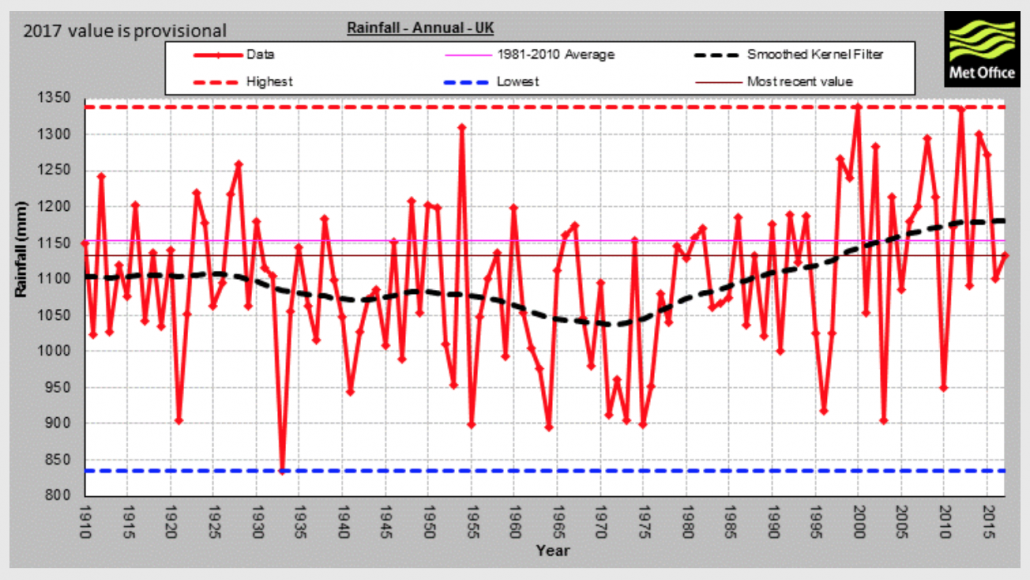
UK annual rainfall between 1910 and 2015. Source – metoffice.gov.uk
The top five wettest years in the UK
1. 2000 – 1337.3mm
2. 2012 – 1330.7mm
3. 1954 – 1309.1 mm
4. 2008 – 1295.0mm
5. 2002 – 1283.7mm
Preliminary research from the Met Office also suggests we may have seen a change in the nature of the rain we get, with ‘extreme’ rainfall becoming more frequent.
An analysis of 1 in 100-day rainfall events (e.g. you would only expect one significant event in 100 days)since 1960 indicates these ‘extreme’ days of rainfall may have become more frequent over time.
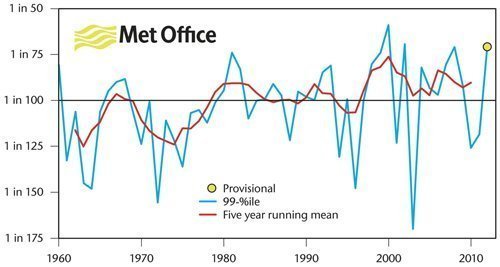
The above graphic shows the frequency of what climate averages tell us should be roughly 1 in 100-day heavy rainfall events in each year. Over time, this gives a view of the frequency of ‘extreme’ rainfall. Source – metoffice.gov.uk
Impact:
There will be increased levels of rainfall, particularly over a short period through intense downpours. This is likely to result in a higher frequency of flash flooding.
Temperature
Data from the Met Office suggests mean temperatures in the UK are increasing. There has been an increase from around 8.3 degrees Celsius in 1910 to 9.25 degrees Celsius in 2015. This is an increase of almost one degree Celsius, and 0.5˚C higher than in the 1970s.
Although it is clear that the climate is warming in the long term, note that temperatures aren’t expected to rise every single year. Natural fluctuations will still cause unusually cold years and seasons.
In the future, summer temperatures in the south-east of England are projected to rise by:
- over 2˚C by the 2040s (hotter than the 2003 heatwave, which was connected to 2,000 extra deaths in the UK)
- up to nearly 4˚C by the 2080s
Impact:
Increasing temperatures can lead to water shortages and droughts. This can lead to steps being taken to reduce water use, such as hosepipe bans.
Wind
The UK is becoming windier. This is likely due to an increase in low-pressure systems crossing the UK compared to high-pressure systems, which bring calmer conditions. The graph below shows the number of ‘calm’ days each year since 1993. A calm day means the wind has not been recorded as 10 knots or more in at least 20 UK weather stations. As shown in the graph below, there is a declining trend in the number of calm days.
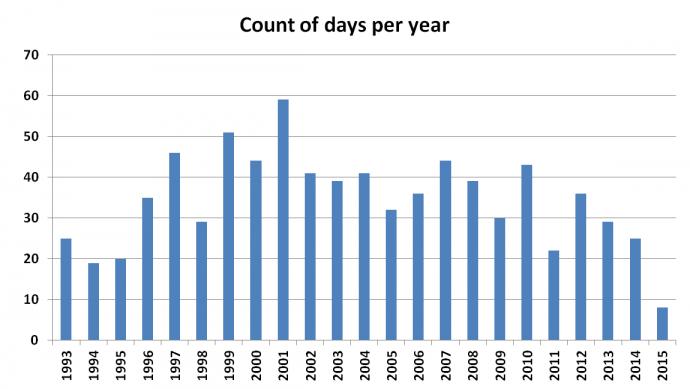
The number of “calm days” each year since 1993. Source: Met Office
Impact:
Strong winds can cause damage to properties and disrupt the transport infrastructure. Falling trees and debris can cause injury or even death. Winds tend to be strongest in upland areas and on the coast.
Heatwaves
The UK sometimes experiences heat waves. These are extended periods of hot weather. During these periods, levels of air pollution can increase, leading to people experiencing respiratory (breathing) problems. The tourist industry benefits from this type of weather. Extended heat waves can lead to droughts (lack of rainfall (precipitation).
Snow and Ice
Cold conditions occur if the usual depressions (low-pressure systems) are not passing over the UK, as happened during the winter of 2014-15 and the Beast from the East cold spell. Cold snaps lead to schools and businesses closing, causing significant disruptions to the transportation network. Death can occur due to low temperatures, and injuries occur from people slipping and falling.

